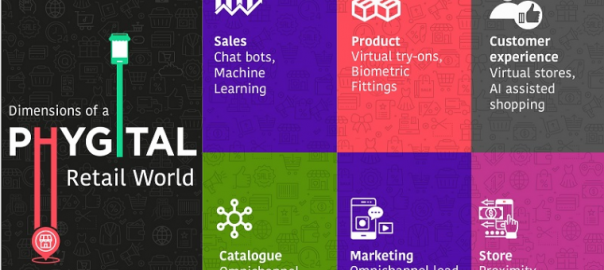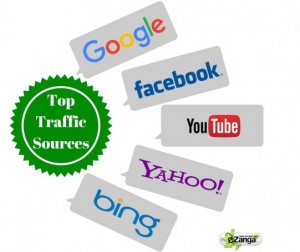Agreed, the headline is slightly presumptuous, in light of the third wave looming large and governments’ globally gearing up for the same.
That said, with vaccination drives going on in full swing, mask-mandates being lifted, travels resuming, and offices reopening, people are actually heaving a sigh of relief – a virus of good feeling is rippling across the cities. But, please don’t take my word for it! America’s leading retail brands have gone on to report that their foot traffic has rebounded earlier than expected, so much so that the numbers might exceed their 2019 sales performance.
The point is consumer behavior is expected to upend big-time post-pandemic, partly because some customers might want to pursue their pre-pandemic routines, and mostly because some customers might wish to continue with new customer engagement models launched during the pandemic.
Here I have cherry-picked simple, straightforward strategies for both kinds of retail store owners to embrace post-pandemic.
A] For Digital Store Owners: Upgrade your digital assets such as Apps, Chatbots, Webpages, Paid Searches, and so on.
B] For physical store owners: Reinvent in-store experiences by proffering Phygital Experiences, Getting Supply chain stress-tested, Converting physical stores into Fulfilment centers for BOPIS, Curb-side picks, and Grocery Apps.
A] Digital Store Owners: Streamline your Digital Assets to Dial-Up Customer Experiences
COVID-19, if anything, has dramatically diminished foot traffic as more and more customers happened to adopt the safety of online stores and chose social distancing measures. So it comes as no surprise that the online sales grew by a staggering 25 percent in two weeks in March 2020, spearheaded by grocery sales, as opposed to a 14 percent compound annual growth rate in the past four years.
The point is: These kinds of pandemic-driven online consumer shopping habits should prompt retailers to dial-up their digital presence post-pandemic, as well, as many customers may want the new engagement models to stay. Sure enough, people may want to visit physical stores for apparel and footwear but not for lower involvement items like groceries and home care products.
Meaning shoppers would still be interested in-home delivery of products, curbside pickup, and buy online, pick up in-store (BOPIS).
According to Mckinsey’s report, BOPIS grew 28 percent year-over-year in February compared with 18 percent in January, and grocery delivery is up by 57 percent. In addition, consumers report high intention to continue using models such as BOPIS (56 percent) and grocery delivery (45 percent) after the pandemic.
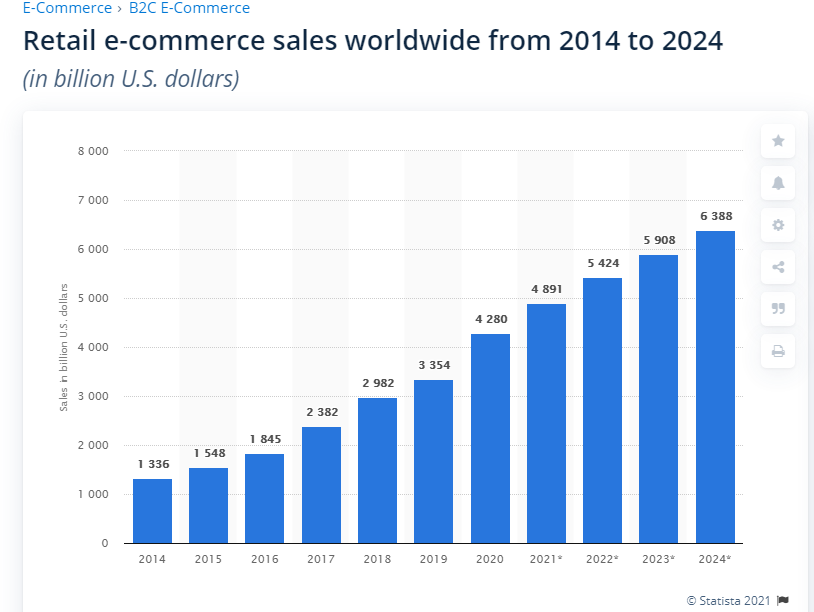
According to business data platform Statista.com in 2020, retail e-commerce sales worldwide amounted to 4.28 trillion US dollars, and e-retail revenues are projected to grow to 5.4 trillion US dollars by 2022.
Fortunately or unfortunately, COVID-19 has got people from all generations used to the convenience of online shopping and especially those who want groceries and food to be home delivered. In short, even if customers are coming out of COVID, they’d still prefer to shop the convenient way.
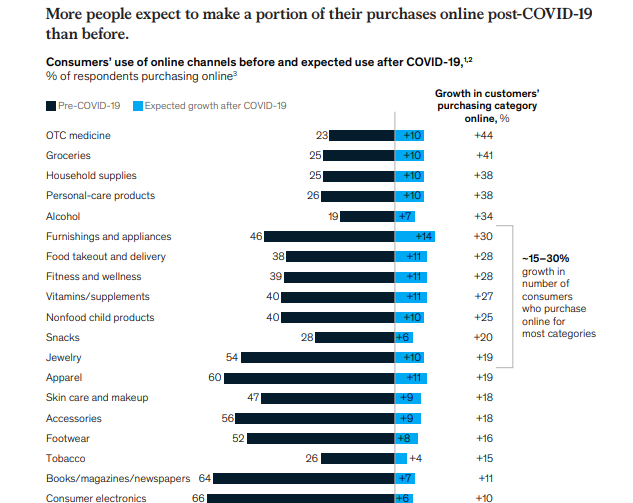
Post Covid online sales
Source: mckinsey.com
Here are five steps to Amp up your Online Store Experience for 2021 and Beyond
#1. Accelerate the use of Paid Search & Paid Social
If you think paid search is not your cup of tea, think again. Paid search using high commercial intent keywords will not only drive traffic to your site but attract qualified sales and leads as even Google prefers high commercial intent keywords over domain authorities when customers Google for products.
On the other hand, through the use of featured products and clickable content, social media channels can be made more shoppable.
#2. Augment Customer Engagement through Apps and Chatbots
Safer-at-home orders led companies to prioritize apps to ensure continual customer engagement; retailers with established mobile apps witnessed record downloads. In retrospect, 45 to 50 percent of retailers plan to prioritize mobile apps this year. All this means retailers shouldn’t think twice about launching a customer-friendly app and chatbots going forward.
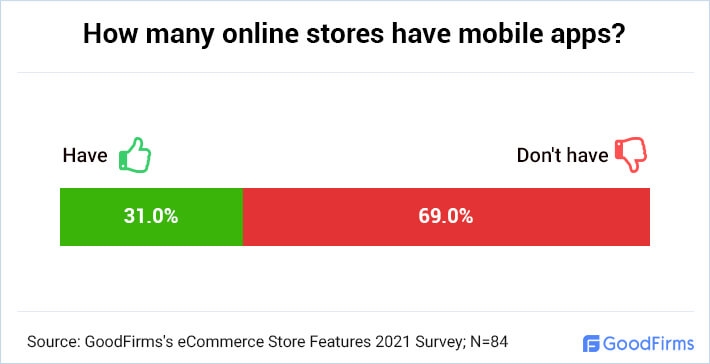
With pandemic emptying call center offices and many companies facing staff shortages, chatbots were helping out with routine operations, answering customer queries about shipping and returns, and even to the point of taking orders. Since the chatbots were well-received by the end-users during the pandemic, there shouldn’t be any reason why retailers should stop using them post-pandemic as well.
#3. Streamline Website pages
It’s almost a no-brainer now that the site’s speed and stability are paramount to increase conversions. The ideal load time for peak conversions is 2.7 seconds max. A 100-millisecond delay would reduce conversion by 7%. Bottom line: You need to increase the load speed of your website.
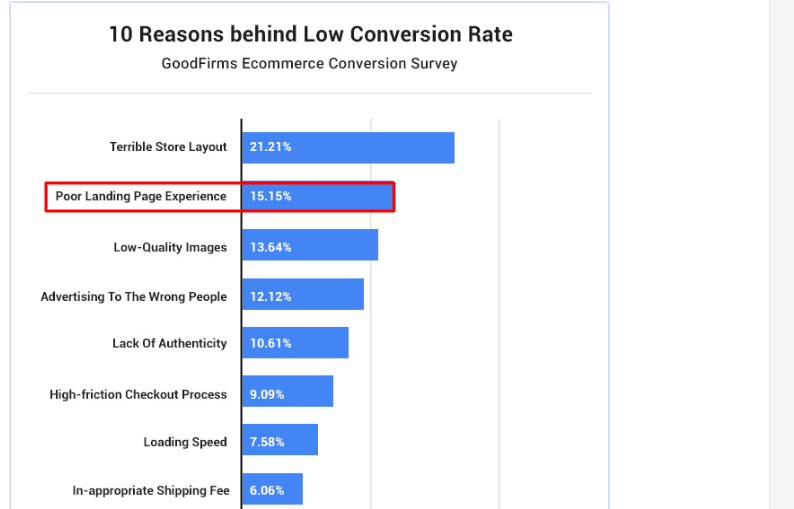
Ten reasons behind low eCommerce conversion according to GoodFirms survey
Further, make best-selling products easy to find to make the customer journey seamless and, more important, set up high-functioning landing pages and ensure consistent messaging across marketing channels.
#4. Implement Voice-activated Shopping
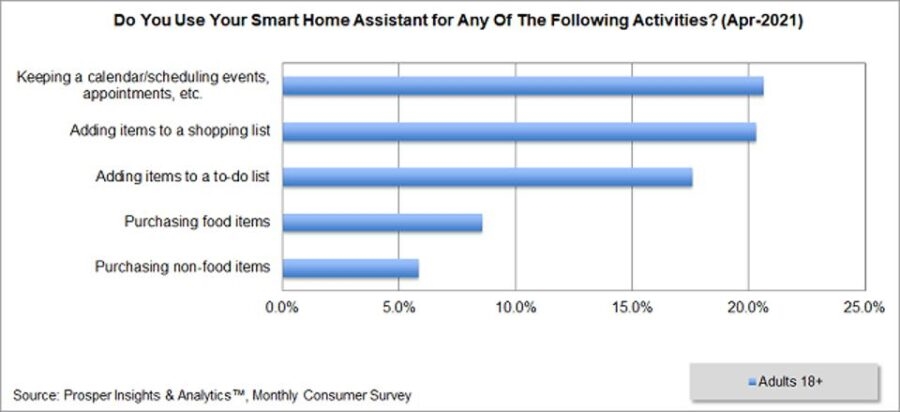
Voice-activated shopping using smart home assistants
With the rise in online shopping, the adoption of voice-enabled smart home assistants for both delivery and BOPIS is expected to rise. Amazon is already the leader in the space. Not surprisingly, Google is also following suit by partnering with large retailers like Target and Walmart to offer voice-activated shopping experiences to customers.
#5. Focus on Fast, Free delivery
Online grocery shopping would still be facing the same kind of online rush as it was during the pandemic. According to the Coresight Research survey, 50% of U.S. consumers expect fast and free delivery in the post-Covid future. Two-or even one-hour delivery window services would be in demand compared to next-day delivery in metropolitan areas. For deeper insights on running an eCommerce store in 2021, read: 20 Features of a Successful eCommerce Store in 2021.
B. Physical Store Owners: Reinvent In-store experiences for the Customers
Amidst the drumroll of reports announcing bankruptcy of retail stores and an uptick in online shopping, running an in-store may seem arguably irrational these days. The good news is: in-stores are not dead. Really? Yes.
According to RIS News, “retail apocalypse” is largely an overstated thing. Amazingly, brick-and-mortar sales powered by curbside pickup and buy-online pickup-in-store (BOPIS), generated sales of over $ 18.5 trillion in 2020. By 2024, 78% of the retail sales will happen in stores. Thus, a view by a specific section of society to ignore the power of physical stores is sadly short-sighted.
In short, physical retail stores will continue to be the epicenter in the post-COVID future.

Acknowledging the resilience of physical stores, even eCommerce giants like Amazon is looking for opportunities to solidify its retail store repertoire as it intends to acquire JC Penny’s entire or part of its 846 store estates.
Here are four steps to Amp up your offline store experience:
#1. In-stores as Fulfilment Arms for Digital Sales – BOPIS, Curb-side pickups, and Apps
As already mentioned, there’s a growing trend of BOPIS among U.S. consumers. And it’s expected to grow more dominant going ahead. And given that apps like Instacart don’t emulate the Amazon warehouse model rather depend on the infrastructure and network of the local grocery stores to fulfill their orders, physical stores could witnesses significant foot traffic in the upcoming months.
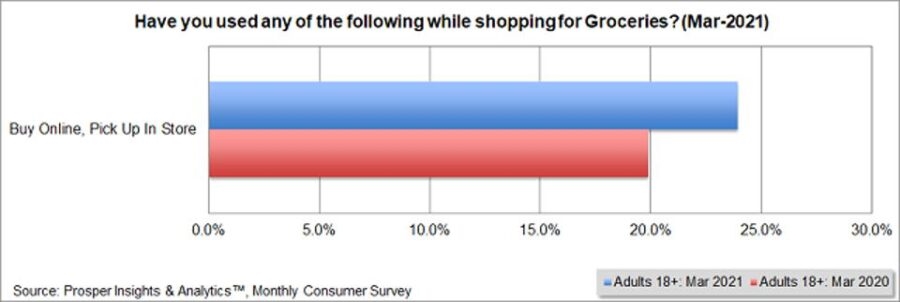
Put another way, in-stores need to reinvent themselves as fulfillment centers by installing systems to ensure on-time delivery of goods and consistent experience. The stores that make consumers wait in queues for long hours or are always falling short of inventory will have to pull up their socks.
#2. Adopt Phygital Practices
For the starters, phygital means the intersection of physical and digital experiences. Though the omnichannel offers a unified experience, there are still gaps that needed to be filled in. The new phenomenon Retail Phygital bridges these gaps through different technologies, thereby bringing the online and offline world together like never before.
Through Phygital, in-store owners would be able to offer a more personalized and engaging experience to customers. Some phygital practices retail store owners should implement right away.
a] Livestream Shopping
Livestream shopping enables customers to engage with in-store employees and experts in real-time. It helps customers visualize products, familiarize them with features, clarify queries, and place orders during live-stream.
Nordstrom, Macy’s, and Avon are among the latest players embracing live streaming, where consumers can shop in real-time while watching live videos.

Source: forbes.com
According to Coreinsight Research, Livestreaming is already a rage in China, where its live-streaming market tracked $ 150 billion in 2020. It’s expected to reach $ 300 billion in 2021, even as the U.S. is trying to catch up.
b] Virtual appointment
In-store sales associates could use videoconferencing platforms to offer virtual appointments to customers. This way, sales agents can help customers find products that meet their needs and learn ways to serve customers better online.
Curious to know about the various technologies that comprise phygital? The seven technological advancements that form an integral part of phygital experience include: Internet of Things, Facial Recognition, Autonomous Delivery Robots, Store Assistants, Cashierless Stores, Augmented shopping, and Voice commerce.
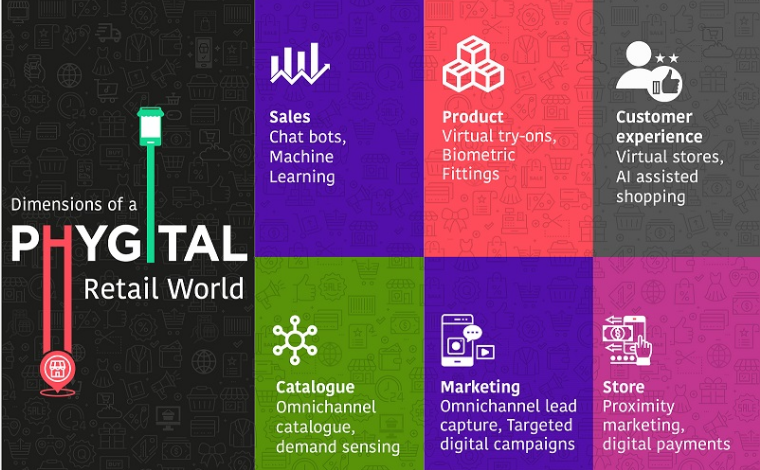
Source: capillarytech.com
C] Cashierless Technology :
As you already know, cashier-less technology powers Amazon Go Stores, whereby the customer can enter the store just by scanning the Go app and exit without any fuss. As in, they don’t have to stand in the checkout line to make payments, as cameras and sensors track the items they choose and charge them while leaving. Simply put, customers walk into the store, select, and pay without waiting in line. Now Amazon is selling its cashier-less technology, “Just Walk Out,” to other retailers as well.
#3. SafeX
While customers may love the liberty of walking in and out of the stores post-COVID, they’d want to it as quickly and as safely possible. In other words, physical stores should offer a safer (SafeX) environment to customers to remove their anxieties and enable in-person interactions. These efforts could be in the form of physical distancing, sanitizing surfaces and products, and communicating effectively with customers.
#4. Supply chain stress testing
Businesses should time and again run stress tests to figure out risks within the supply chain. They should keep checking in with critical suppliers, factories, logistics centers, and inventories of finished products to ensure a continuous supply of products. A business continuity plan should also be charted out in case of disruption or any new kind of crisis.
Wrapping Up
Both eCommerce stores and physical stores are here to stay. You cannot do away with either of them. So better scale them up in a way that generates more traffic and ignites sales.
Digital & Social Articles on Business 2 Community
(110)
Report Post